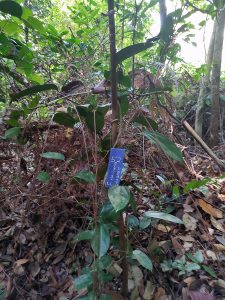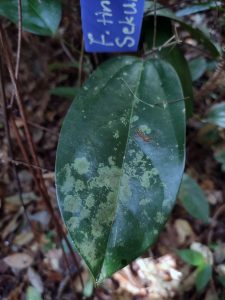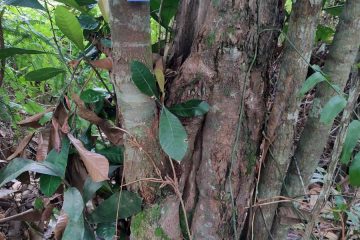52
Fibraurea tinctoria Lour.
Other names:
Akar sekunyit – Fibraurea tinctoria Lour. – Menispermaceae[1]
General information:
A large woody, entirely glabrous climbing shrub, producing stems up to 40 m long and 5cm in diameter[1]
The plant is sometimes harvested from the wild as a local source of medicines and dyestuff. This species is one of many examples of a dye-producing plant which has completely lost its importance through the advent of chemical dyes. Although it was at one time widely used for dyeing, often being traded, its use nowadays is probably almost exclusively restricted to traditional medicine[2].
Distinguish botanical characteristics:
The leaves are arranged spirally, thinly coriaceous, simple and entire, exstipulate, elliptic to ovate. The flowers are in axillary or ramiflorous lax panicles, with 6 whitish or yellowish inner sepals minute outer ones while the petals are lacking. The male flowers are sweetly scented, with 6 stamens which have very thick columnar filaments. The fruit is composed of up to 3 yellow or orange drupes borne on a small knob-like carpophore[1]
Uses:
The plant contains berberine, a compound used to treat the eyes. A decoction of
Root: administered after childbirth.
Stem: used for curing an ulcerated nose. A decoction prepared from the stem is given to patients with dysentery in Java.
Leaves: effective for headaches.[3]
Major/bioactive phytochemicals:
The major alkaloid present in roots and stems is palmatine; other alkaloids found include jatrorrhizine, colombamine and magnoflorine[4]
References:
[1] Fibraurea tinctoria Lour.( Menispermaceae) https://www.mybis.gov.my/sp/37853
[2] Ecocrop Publication Website http://ecocrop.fao.org/ecocrop/srv/en/home
[3] Plant Resources of Southeast Asia Publication Website:http://proseanet.org/
Publisher.
[4] Tropical Plants Database, Ken Fern. tropical.theferns.info. 2022-06-20. <tropical.theferns.info/viewtropical.php?id=Fibraurea+tinctoria>
SK & SZMS, 2022


